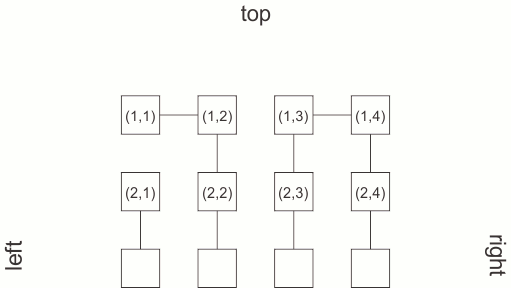ublo
bogdan's (micro)blog
bogdan » how to build a maze
01:42 pm on Oct 7, 2018 | read the article | tags: howto
in this post i’ll use C to construct a maze, that will be later used for my swarm experiments.
i’ll be using a graph-model for the maze: each vertex is a room from the maze, which is connected by edges to other rooms. in a 2-D classic maze of size m×n, with m spanning from top to bottom and n spanning from left to right, each room has at most 4 neighbors. this means each vertex in my graph will have at most 4 edges: top, bottom, left and right. the total number of edges is m×(n-1) for vertical edges (top, bottom) and (m-1)×n for horizontal edges (left, right). in order to create a maze, in the previously described graph, i’ll choose using a version of Dijkstra algorithm a maximum spanning tree. to make the maze random, i’ll mark each edge with a random weight and then run the maximum spanning tree algorithm.

i’ll be using matrices as data structures. this means that each vertex will be labeled with a pair (i,j) with i from 0 to m-1 and j from 0 to n-1. as the graph is not oriented, i’ll have:
- if (i,j) is linked to (i,j+1), than i’ll store in my matrix, on position (i,j) the weight of the edge [(i,j),(i,j+1)];
- if (i,j) is linked to (i+1,j), than i’ll store in my matrix, on position (i,j+n) the weight of the edge [(i,j),(i+1,j)];
- no need to store the [(i,j),(i,j-1)] edge as it’s equivalent to [(i,(j-1)),(i,(j-1)+1)];
- also, no need to store connections at the lower and right edge of the maze;

the number of required edges’ weights can be held in a m×(2×n-1)-n vector, corresponding to an incomplete m×(2×n-1) matrix.
building the weight matrix
this step is quite easy. just loop over all m×(2×n-1)-n and assign them a random value between 1 and 255. i’ll be using 0 to represent edges that are missing.
/**
* the function initializes the weights matrix as described above;
* @param m (int) the dimension of the maze on top-bottom axis;
* @param n (int) the dimension of the maze on left-right axis;
* @returns: an uint8_t matrix, of size (m-1)*2*(n-1) filled with random data;
*/
uint8_t * maze_weight_init (int m, int n) {
/** @var maze the weight matrix */
uint8_t * maze;
/** @var c is a variable index */
int c;
/** i reserve the space in the computer memory for the matrix */
maze = (uint8_t *) malloc ((m * (2 * n - 1) - n) * sizeof (uint8_t));
/** if memory reservation is successful, i'm filling the matrix */
if (maze != NULL)
for (c = 0; c < m * (2 * n - 1) - n; c++)
*(maze + c) = (uint8_t) ((1 + rand ()) % 256);
return maze;
}
tip:
the matrix is stored as a single vector, meaning a cell on the position (i,j) can be accessed by finding as the (i×cols+j)-th component of the vector. this map is bijective, meaning that the i-th component of the vector corresponds to position (i/cols, i%cols) in the matrix, where / is the integer division and % is the reminder operator.
sorting the weight matrix
the matrix is not useful like this. it needs to be sorted. i'm using a simple (inefficient) bubble sort algorithm. i'll take advantage of how i stored the matrix so i can simply arrange the associated vector. i'll create a vector into which i'll keep the association of indices.
bubble sort works like this: take the first weight from the vector, and if it's heavier that the one above, swap their places. this has to be repeated until the entire vector is sorted: this happens when there are no swaps on a swipe.
/** the function is sorting the associated vector V, returning a mapping of the
* sorted indices, M, with V(i) being the original vector, while V(M(i)) is the sorted one
* @param weights (uint8_t *) is the original vector
* @param m (int) is the top-bottom size of the maze
* @param n (int) is the left-right size of the maze
* @returns: an int mapping vector between the sorted version and the original one
*/
int * maze_edges_sort (uint8_t * weights, int m, int n) {
/** @var indices the vector containing the sorted mapping */
int * indices;
/**
* @var c a variable index
* @var t a temporary variable used in swapping two indices
* @var o a temporary variable storing last index swapped
* @var l, initially the length of the weights vector,
* after, the length of the unsorted vector
*/
int c, t, o, l = m * (2 * n - 1) - n;
/** initialize indices with an identity mapping i->i */
indices = (int *) malloc (l * sizeof (int *));
for (c = 0; c < l; c++)
*(indices + c) = c;
if (indices != NULL)
/** while there's still some unsorted part of the vector */
while (l > 0) {
/** o holds the last swapped value */
o = 0;
/** i'm looping until the end of the unsorted vector */
for (c = 1; c < l; c++) {
/** if the weights don't respect the sort order, swap them */
if (*(weights + *(indices + c - 1)) > *(weights + *(indices + c))) {
/**
* of course, i'm swapping indices in the mapping,
* not real values, as the initial vector remains
* unchanged, only the mapping function deviates from
* identity map
*/
t = *(indices + c - 1);
*(indices + c - 1) = *(indices + c);
*(indices + c) = t;
/** store the last swapped index */
o = c;
}
}
/** the length of the unsorted vector equals the last swapped index */
l = o;
}
return indices;
}
building the maximum spanning tree
this algorithm is more complex that the previous ones. for easier understanding, i need to explain some notions:
- a graph is a collection of vertices and edges, each edge connecting two vertices; it can and usually has loops - meaning starting from one vertex, it can be reached again going edge-by-edge; like a city with ring-roads;
- a tree is a graph with no loops; it means that starting with a vertex, and going edge-by-edge you'll never get to the same vertex again; like a computer network;
- in a graph (including a tree), a sub-tree is a collection of vertices and edges from the initial graph that behave like a tree - there are no loops;
i'll start with an empty set of sub-trees from the original graph. this will be called a forest set. forests have at least one tree. at the end of the algorithm i'll have in this set a tree that will link all vertices from the original graph. this is called a maximum spanning tree.
with each sorted edge, lighter to heavier, i'll do the following:
- if the edge is not connected to any sub-tree from my sub-tree set, i'll add the edge to the sub-tree set, coloring it with a new color;
- if the edge has one vertex connected to a sub-tree in my sub-tree set, i'll add the edge to the sub-tree set, coloring it with the same color as the rest of the sub-tree;
- if the edge has vertices on different sub-trees, than i'll add the edge and color both sub-trees, as well as the edge, with a common color. i'll use indexed colors, so i'll choose the minimum color;
- if the edge has vertices on the same sub-tree, i'll skip this edge; in this situation, the edge is creating a loop in the tree, making it a graph;
/**
* the procedure takes as parameters a weight matrix together with its size
* and modifies in place the weights matrix, removing the unnecessary edges
* an edge is kept, if the weight is strict positive, while an edge is
* deleted, if its weight is zero.
* @param weights (uint8_t *) is the weight vector
* @param m (int) is the maze top-bottom size
* @param n (int) is the maze left-right size
*/
void maze_init (uint8_t * weights, int m, int n) {
/**
* @var indices is the sorted mapping for the weights vector;
* @var matrix is a vector-stored matrix that has 0 on (i,j)
* 0 on (i,j) position, if the (i,j) vertex was not visited
* color>0 on (i,j) position, if the (i,j) vertex was visited
* and (i,j) is part of the "color" sub-tree
*/
int * indices, * matrix;
/**
* @var c,d are variable indices;
* @var row,col are the row and column indices in the @see matrix
* @var n_row,n_col are the indices for the vertex connected to
* (row,col);
* @var min_color is the minimum "color" when merging an existing
* sub-tree with a new edge. the edge can link two existing
* sub-trees, meaning i'll have to choose a single color for both
* @var max_color is analog with @see min_color;
* @var color is the current available color for new sub-trees;
*/
int c, d, row, col, n_row, n_col, min_color, max_color, color = 1;
/** reserve memory for the is-visited? matrix */
matrix = (int *) malloc (m * n * sizeof (int));
for (c = 0; c < m * n; c++)
*(matrix + c) = 0;
/** sort the graph weights */
indices = maze_edges_sort (weights, m, n);
/** loop through sorted edges */
for (c = 0; c < m * (2 * n - 1) - n; c++) {
/** get the edge first vertex label as (row, col) */
row = *(indices + c) / (2 * n - 1);
col = *(indices + c) % (2 * n - 1);
/**
* based on how is stored, get the label for the
* second vertex associated with the edge
*/
if (col < n - 1) {
n_row = row;
n_col = col + 1;
}
else {
col = col - n + 1;
n_row = row + 1;
n_col = col;
}
/**
* check if the current edge can be added to the forest:
* the edge needs to fulfill all requirements:
* - the edge is not already part of a tree, meaning that both
* vertices are the same non-zero color
*/
if (
(*(matrix + row * n + col) == *(matrix + n_row * n + n_col)) &&
*(matrix + row * n + col) > 0
) {
*(weights + *(indices + c)) = 0;
continue;
}
/**
* find the color of the new vertices, by getting minimum and
* maximum color. both can be zero, if we start a new sub-tree
*/
if (*(matrix + row * n + col) < *(matrix + n_row * n + n_col)) {
min_color = *(matrix + row * n + col);
max_color = *(matrix + n_row * n + n_col);
}
else {
min_color = *(matrix + n_row * n + n_col);
max_color = *(matrix + row * n + col);
}
if (min_color == 0) {
/**
* here, min = max = 0, this means we have a new sub-tree
* so i color it with the next available color
*/
if (max_color == 0) {
*(matrix + row * n + col) =
*(matrix + n_row * n + n_col) = color ++;
}
/** here, the edge has an open end, the other is connected */
else {
*(matrix + row * n + col) =
*(matrix + n_row * n + n_col) = max_color;
}
}
else {
/**
* here min, max > 0, both different, this means that the
* edge is connecting two different color sub-trees, so i
* make both the same color (min color)
*/
*(matrix + row * n + col) =
*(matrix + n_row * n + n_col) = min_color;
for (d = 0; d < m * n; d++)
if (*(matrix + d) == max_color)
*(matrix + d) = min_color;
}
}
/** remember to free the reserved memory */
free (indices);
free (matrix);
}
putting it all together
piece of cake. first, i'll have to initialize my weights. than, to build the maximum spanning tree. a good exercise is to display the maze on the screen using ASCII art.
#include/** required for malloc, srand and rand functions */ #include /** useful for printing stuff, with printf */ #include /** i need the uint8_t definition */ #include /** i need the time function */ /** * this is the normal, unix-style format for the program entrypoint * @param argc (int) is the number of arguments from the command line; * @param argv (char **) is an array of strings, containing the command line arguments; * @returns: an integer, zero if no error has occurred. */ int main (int argc, char ** argv) { /** @var weights (uint8_t *) my weights matrix */ uint8_t * weights; /** @var m, n (int) the maze size */ int m = 4, n = 4; /** make the random numbers random :-) */ srand (time (NULL)); /** initialize the weights matrix */ weights = maze_weight_init (m, n); /** build a maximum spanning tree from the matrix */ maze_init (weights, m, n); /** tell the operating system that there's no error */ return 0; }
bogdan » enel: schimbare titular contract
01:19 pm on Apr 29, 2013 | read the article | tags: howto
pentru a vă scuti de un stat la o coadă infernală, anexez mai jos documentele necesare pentru schimbarea titularului de contract Enel pentru persoane fizice. din cerere reiese că sunt necesare urmatoarele documente:
- copia actului de identitate (trebuie sa vă prezentați și cu originalul);
- actul de proprietate sau alt document care să ateste dreptul de folosință asupra spațiului care face obiectul locului de consum, respectiv, acceptul proprietarului de încheiere al contractului (la fel ca mai sus, originalul este și el necesar);
- convenția de exploatare (unde e cazul);
și din informațiile de la relații clienți:
- ultima factură și indexul contorului.
Enel Schimbare Titular Persoană Fizică

bogdan » proiect. curs fulger
09:05 pm on Feb 13, 2013 | read the article | tags: howto
The word project comes from the Latin word projectum from the Latin verb proicere, “before an action” which in turn comes from pro-, which denotes precedence, something that comes before something else in time (paralleling the Greek ???) and iacere, “to do”. The word “project” thus actually originally meant “before an action”.
— wikipedia
ceea ce scriu în rândurile următoare nu este o rețetă completă, ci mai degrabă un schelet universal pentru structurarea ideilor și pregătirea planului unui proiect (indiferent de tip):
1. alege-ți o idee. încadreaz-o într-un context și găsește-i o justificare pe care o testezi cu prietenii care nu sunt implicați. testul este trecut atunci când aceștia înțeleg clar despre ce e vorba.
2. vezi ce ai putea să măsori în ideea anterioară, de preferat cu cifre și stabilește câte un obiectiv pentru fiecare măsură.
3. detaliază cum poți să atingi fiecare obiectiv, sub forma unui algoritm, cu pași, cu oameni implicați și cu resurse de care ai nevoie.
4. fă un sumar al contribuției oamenilor și unul al necesarului de resurse. vezi de unde poți obține resursele respective.
5. nu uita de cifrele de la punctul 2. găsește o metodă prin care să le poți urmări constant.
6. folosind cifrele de la punctul 2 analizează modul în care implementarea ideii va afecta contextul general în care ai încadrat-o inițial.
7. gândește-te ce vei face când proiectul se va termina. cum poți folosi resursele și experiența rezultate din proiect pentru a obține alte rezultate în direcția care te interesează.
sunt o mulțime de firme care oferă cursuri de management de proiect. majoritatea îți prezintă fix algoritmul de mai sus îmbrăcat în limbaj de lemn, matrice (pronunțate incorect ”matrici”) și abrevieri mnemonice inutile uimindu-te că deși ai fost SMART, proiectul tău nu a fost ales pentru implementare.
sursă foto: www.eci.com

bogdan » 5 sfaturi despre cum să-ți asamblezi singur mobila
05:01 pm on Oct 14, 2012 | read the article | tags: howto
sărind peste context, mi-am luat mobilă pentru dormitor. sursa? www.targuldemobila.ro. nu insist pe detalii, ci pe faptul că a trebuit să-mi asamblez singur un pat, două noptiere, un șifoner cu patru uși și o comodă tv. mai jos 5 sfaturi referitoare la proces:
1. deși în manual scrie că o persoană poate asambla oricare dintre obiectele de mai sus cu o șurubelniță în cruce, un inbus (inclus) și un ciocan, nu recomand pornirea la drum fără o șurubelniță electrică cu doi biți (unul în cruce și un inbus potrivit) și un burghiu de 1.6 sau 2mm.
2. deși în manual scrie că pentru unele bucăți ar trebui să folosiși ținte (sunt incluse), recomand achiziționarea unor șuruburi suplimentare pentru a prinde în special spatele șifonerului. în timp țintele tind să alunece și să scape. am avut noroc și în pachetele pe care le-am primit am găsit o mulțime de șuruburi suplimentare.
3. deși în manual nu scrie, acolo unde nu sunt semne pentru ?urub (ex. balamalele ușilor, rotișe pentru deplasare) folosește burghiul de mai sus pentru a crea un canal de ghidaj: previi spargerea materialului iar șurubul va intra mult mai repede la locul lui.
4. deși în manual nu scrie, nu strânge toate șuruburile ”din prima”. mai bine prinde-le pe toate și când obiectul este asamblat, finisează-l prin strângerea tuturor șuruburilor.
5. deși în manual nu scrie, ar fi bine să ștergi toate părțile componente cu solușie pentru mobil? (ex. pronto) înainte de a le asambla.
Alte chestii care-mi vin în minte:
1. pentru protejarea parchetului în timpul deplasării unui corp mai voluminos, folosește un covoraș inserat între acesta și parchet. e mai ușor de deplasat și nu vei zgâria parchetul.
2. încearcă să construiești aproape de locul unde va fi așezat respectivul obiect.
3. ar fi bine să mai fie cineva care să-ți dea o mână de ajutor. nu mă înțelege greșit, poși să le asamblezi singur, însă ar fi puțin mai ușor.
4. pentru rezistență sporită, unele îmbinări ar putea fi unse cu adeziv (aracet). spre exemplu interiorul patului.
5. nu te zgârci la ținte sau șuruburi. dacă nu ai suficiente, cumpără.
6. din balamale poți regla modul în care se închid ușile. au câte două șuruburi. folosește-le.

bogdan » cool youtube thing: pause the video, the …
10:07 pm on Jan 8, 2011 | read the article | tags: howto
cool youtube thing: pause the video, then press and hold left or right arrow key and while holding, press and hold up or down arrow key. you’ll be able to play snake over the frozen frame =).
bogdan » dunno why i put this under howto. cause …
11:12 pm on Oct 7, 2009 | read the article | tags: howto
dunno why i put this under howto, cause i won’t give you any recipes today. i just want to say that i’ve recently bought an arduino. from here. i’ve managed to play a little with it and i’m trying to build a shield. and so far, i love it. ‘ll be back. with details =)
bogdan » acte necesare pentru eliberarea certific …
09:46 pm on Oct 4, 2009 | read the article | tags: howto
acte necesare pentru eliberarea certificatului de atestare fiscală:
1. cerere tip; 2. copie cod fiscal; 3. copie carte de identitate; 4. dovada de sediu social; 5. declarație pe propria răspundere că societatea nu deține puncte de lucru cu obligații declarative; 6. împuternicire; 7. timbre fiscale, 2×4 lei; 8. dosar cu șină.
bogdan » i had lots of problems shoving movies on …
10:56 am on Sep 29, 2009 | read the article | tags: howto
i had lots of problems shoving movies on my ipod. seems like i found the recipe. also works for samsung omnia. with ffmpeg.
ffmpeg \ -i "input.avi" \ -b "768k" \ -s "400x226" \ -vcodec libxvid \ -r 25 \ -ab "128k" \ -acodec libfaac \ -ac 2 \ -ab "64k" \ -f mp4 \ -y "output.mp4"
bogdan » ever wanted to know what a website needs …
10:44 pm on Sep 27, 2009 | read the article | tags: howto, me, replied
ever wanted to know what a website needs? most of you don’t know. so here it is. first, you need the files you want to show to the world. if you want just a blog, get them from here. second, get hosting. this should provide a dns service – to map your name to the server’s ip address – and the webserver that keeps your files. third, you need your domain name. from here. so don’t bug me anymore for this things. please!..
find me:
in my mind:
- #artist 2
- #arts 4
- #away 3
- #bucharest 1
- #buggy 2
- #business 1
- #clothes 1
- #comics 1
- #contest 3
- #dragosvoicu 1
- #education 1
- #food 2
- #free-ideas 1
- #friends 14
- #hobby 22
- #howto 9
- #ideas 29
- #life lessons 3
- #me 59
- #mobile fun 4
- #music 51
- #muvis 17
- #muviz 13
- #myth buxter 1
- #nice2know 15
- #night out 1
- #openmind 2
- #outside 3
- #poems 4
- #quotes 1
- #raspberry 4
- #remote 56
- #replied 51
- #sci-tech 7
- #sciencenews 1
- #sexaid 6
- #subway 39
- #th!nk 4
- #theater 1
- #zen! 4